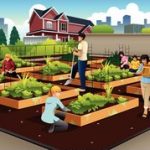“As the full scale of the imminent crisis hits us, our response will be proportionally dramatic, mobilising as we do in war. We will change at a scale and speed we can barely imagine today, completely transforming our economy …” Paul Gilding ‘The Great Disruption’, 2010.
How do you feel reading Paul Gilding’s comment?
When he published The Great Disruption in 2010, Australian environmental business consultant Paul Gilding argued that it was time to stop ‘just worrying about climate change’ and instead ‘brace for impact’ because global crisis is no longer avoidable. By ‘global crisis’ he was referring not just to climate change but to the disruption of most of Earth’s systems. In the decade since then, we have witnessed a noticeable acceleration of meteorological and ecological changes indicating that Gilding was correct and we may have ‘reached or passed the limits of our current economic model of consumer driven material economic growth’ on this planet. Hence The Local Resilience Project and This Call To Action.
Do you need proof that a Call To Action is necessary?
In his 2016 book, ‘Thank You For Being Late’, New York Times journalist, Thomas Friedman included 12 graphs illustrating the deterioration of Earth systems from ocean acidification and deforestation through top soil losses and species collapse. Alongside these he placed 12 graphs illustrating the economic trends responsible for these Earth system losses e.g. economic growth, population growth, water use, tourism, resource and energy use. Like Gilding, Friedman was reading the signs of a planet under stress and counselled us to pay attention.
How do you start to engage with The Call To Action?
It’s difficult to ignore the evidence that we need to live differently if we are to survive and leave the Earth habitable for future generations, but what has stopped us from taking action? We’ve been receiving scientific reports on our de-creating activities for more than 30 years. Yes, we’ve been changing our light bulbs, rejecting single use plastic bags and solar panelling our rooftops. More of us are shopping at farmers markets and buying ethical clothing but is that enough to build the kind of resilience we will need as average temperatures and sea levels rise and supply lines, infrastructure and livelihoods become compromised?
Improving our personal and collective resilience will require a different way of thinking about the physical realities of our planet, our economic activity and our human psychology. Albert Einstein once said ‘No problem can be solved from the same level of thinking that created it’, so how do we start thinking differently about what Gilding called ‘the imminent crisis’ and the complex issues associated with adapting to it?
If we’re serious about undertaking a dedicated Call To Action, some of the ways in which we will need to ‘think differently’ include developing:
- a better understanding of the interaction between the planet’s ecology & the economy,
- a deeper appreciation of what it means to be resilient in disruptive times,
- an honest acceptance of the possibility that we may not do enough fast enough.
Increasing numbers of people around the world have already begun these shifts in thinking and a sample of their conclusions is represented in The Conversation section of this website.
How are you feeling about getting involved in the 10 steps of The Call To Action of The Local Resilience Project? Excited? Intimidated? Uncertain? Indifferent? Or ‘all of the above’? If you’re feeling some conflict at this stage its only natural. The crisis that Paul Gilding, Thomas Friedman, Richard Heinburg, George Monbiot, Chris Martenson, David Suzuki, David Attenborough and hundreds of others have been warning us of for more than 30 years is upon us and is presenting an ‘existential threat’ that is hard to ignore and hard to solve. Most of us have been ignoring it for a very long time. How did this happen?
Ignoring The Call To Action:
In my life there have been several calls to action prompting me to make changes in order to deal more resiliently with the crises of climate change and environmental destruction. Some calls came via documentaries and books, some from life choices made by friends and other calls came from personal experience:
- ’An Inconvenient Truth’ (2006) showed me there is no hiding place from climate disruption.
- ‘The Age Of Stupid’ (2009) warned that we might not do enough, fast enough.
- The Brisbane floods (2011), showed me how vulnerable my life is without power.
I managed to ignore all the signs until 2017 when the mountain of evidence won out and I began designing The Local Resilience Project. The recent (2018-19) summer of catastrophic bushfires and monsoonal floods in Australia will be a call to action for many. Or maybe not?
Human nature is a funny thing. Even with the best of intentions to create a more resilient future, our motivation can be hijacked. After reading Naomi Klein’s, ‘ This Changes Everything’ in 2016, I understood why so little had been done to address the crises facing us. Maybe its a survival habit built into us over thousands of years of evolution, but, in general, humans find it difficult to readily accept and integrate ‘new information that does not sit well with our world view or belief systems’. Our immediate initial response is usually denial.
We seem to prefer denial to the uncomfortable acknowledgment of a more inconvenient truth and according to Klein, there are many versions of denial. Her pick for the ways we’ve avoided dealing appropriately with accelerating climate change and ecological damage include:
- We look, and then we look away or we turn it into a joke.
- We look, and then tell ourselves comforting stories about how humans are clever and will come up with a technological miracle to save us.
- We look, but act hyper rational e.g.“ dollar for dollar its more efficient to focus on economic development than climate change, since wealth is the best protection from weather extremes…”
- We look, but tell ourselves we’re too busy to do anything about something so distant & abstract.
- We look, but tell ourselves that all we can do is focus on ourselves, meditate, shop at farmers’ markets, buy electric cars, while omitting to change the very systems that are making the crises inevitable.
- We look, but inevitably, we forget. Remember, then forget again. Engaging in an odd form of ‘on-again-off-again ecological amnesia’ for perfectly rational reasons i.e. we deny because we fear that letting in the full reality of this crisis will change everything.
If Naomi Klein is correct and we all struggle ‘with new information that does not sit well with our world view and belief systems’, how might denial hijack your Call To Action?
If you reflect on your emotional response when you contemplate a future of accelerating climate change, ecosystem collapse and the challenge of having to start living life very differently from now on, what comes up? Do you feel excited and empowered or depressed and overwhelmed? Either way, processing a range of emotions is a natural response to the anticipated disruptions ahead. Though it isn’t within the scope of The Local Resilient Project to offer guidance in emotional processing, there are excellent resources available for this. One such resource is Canadian psychotherapist, Carolyn Baker’s, ‘Navigating The Coming Chaos – A Handbook For Inner Transition’.
In the spirit of helping you think about and respond differently to disruptive conditions ahead, The Local Resilient Project has drawn up a list of actions you, your household and your community can start taking right now. There are 10 in total and although they logically flow on one from the other, there is no one fixed pathway through. Each person and each community will create their own way.
The Call To Action starts with the personal challenge to revisit your Checklist score and transform your ‘No’ responses into ‘Yes’ responses in as short a time as practical. From there on the challenges focus on making broader connections with your local community, ending up with transformative networking with resilient communities and ‘transition towns’ both here and overseas. The choice is yours.
YOUR CALL TO ACTION
[1] IMPROVE YOUR CHECKLIST SCORE:

Go through your Checklist results, note the questions for which you scored a ‘No’. Select one that you feel most inclined to change to a ‘Yes’ right now, and take whatever action necessary to do so. For many of the questions in The Checklist you will find ‘pop ups’ offering a simple explanation about how this particular item or behavioural change can influence resilience.
Enjoy the deep appreciation of how resilience can be enriched by quite simple changes in choice and lifestyle. Commit to reviewing and making changes on a regular basis until you feel your ‘score’ reflects the level of resilience you want.
[2] REACH OUT TO YOUR NEIGHBOURS:
 This Call To Action is not a ‘spectator sport’ and you will find great satisfaction if you treat it as a team effort by sharing it with as many people in your social network as possible. You have to get involved if you want to build a more resilient community.
This Call To Action is not a ‘spectator sport’ and you will find great satisfaction if you treat it as a team effort by sharing it with as many people in your social network as possible. You have to get involved if you want to build a more resilient community.
It doesn’t have to be a nerve wracking experience either. Make it fun and easy – reach out first of all to those neighbours with whom you already have a good connection. If they like and trust you then they will be more open to receiving your invitation to check out The Local Resilient Project and their willingness will encourage your efforts.
Once you’ve had some success with your ‘known neighbours’, reach out to those you don’t know other than to wave hullo in passing. Drop a note in their letterbox mentioning that your household has been discussing resilience lately and asking if they’d like to learn about The Local Resilience Project. A positive response can open many doors for social connection such as a BBQ, an afternoon cuppa at your place or the local park. Eventually this action will help you gather support for the larger activities in The Call To Action such as a ‘Town Hall Meeting’.
[3] INVITE FAMILY, FRIENDS AND CO-WORKERS TO JOIN IN:
 Family is where we learn how to function in the world. Family is our first source of the love and support we need to make it through life’s toughest spots. What better way to return this love and support than by introducing family members to the concept of resilience building? It doesn’t matter where you start the conversation so long as you do it from a place of love e.g elderly parents may require a different approach to the subject of resilience than teenagers and young adults, so tailor your Call To Action with consideration for their age, experience, health and general environmental awareness.
Family is where we learn how to function in the world. Family is our first source of the love and support we need to make it through life’s toughest spots. What better way to return this love and support than by introducing family members to the concept of resilience building? It doesn’t matter where you start the conversation so long as you do it from a place of love e.g elderly parents may require a different approach to the subject of resilience than teenagers and young adults, so tailor your Call To Action with consideration for their age, experience, health and general environmental awareness.
The same tactful approach applies to others in your social networks. Friends and co-workers may thoroughly enjoy what you have to say and be eager to start making changes in their lives. They may be grateful to you for taking the time to share the issues with them because what you are essentially saying to them is: ‘I care about you’. While you may not receive a positive response from everyone, be patient, you never know what impact your conversation may have over time. Remember Paul Kelly’s lyrics: ‘From little things, big things grow’?
It can be smart to initially choose people in your networks who are open minded about the topics included in the Local Resilience Project. Their willingness to participate will boost your confidence and energise your efforts to build a more resilient community. Leave any ‘denialists’ in your family and friendship circles for a time when you’re feeling solid in your own understanding of what is at stake. This makes the hard work easier!
Do your best to make these connections enjoyable and supportive. There is no point trying to convince anyone who isn’t ready. We all have denial filters, comfort zones and trust issues. Tread gently, and if you’re an ‘early adopter’ of resilience strategies, ‘put your own oxygen mask on first’ by building up your household score so that when you’re asked to help others, you’re better able to do so.
[4] CONTACT YOUR LOCAL POLITICIANS:
 The young Swedish climate change activist, Greta Thunberg (https://www.ted.com/speakers/greta_thunberg) had been ‘speaking truth to power’ for a nearly a year before the authorities took her seriously. By standing outside the Swedish Parliament and boycotting school on Fridays Greta attracted millions of supporters around the world. She found an audience of people weary of political inaction over climate change and determined to change this. Even though governments may claim that climate change policies are unrealistic unless the general public make the issue a priority, the reality is that the intractable problems of accelerating climate change and ecosystem collapse will not go away without immediate and decisive political action.
The young Swedish climate change activist, Greta Thunberg (https://www.ted.com/speakers/greta_thunberg) had been ‘speaking truth to power’ for a nearly a year before the authorities took her seriously. By standing outside the Swedish Parliament and boycotting school on Fridays Greta attracted millions of supporters around the world. She found an audience of people weary of political inaction over climate change and determined to change this. Even though governments may claim that climate change policies are unrealistic unless the general public make the issue a priority, the reality is that the intractable problems of accelerating climate change and ecosystem collapse will not go away without immediate and decisive political action.
You don’t have to stand outside your parliament building to get the conversation moving and policy change happening. All you have to do is pick up your smartphone, use your keypad or attend a local council meeting and make your feelings about disruptive climate change and environmental collapse known to your local politicians. If you’re in any doubt about what you can achieve, remember it’s the community that decides who gets elected.
Even if your efforts don’t initially change your politicians’ point of view, at the very least it makes them aware of the significance of the issues. Someone once said that when a politician receives 5 letters/emails on the same subject from different people, s/he pays attention.
How best to get your point across will depend on several things, including how comfortable you feel about speaking to people in authority. A phone call can be the most effective way to communicate quickly but it’s unlikely you will get to speak to the politician directly and if your argument is complex, a letter or email beforehand may bring better results. Your political representatives have thousands of constituents & countless issues competing for their attention, so help them to prioritise your concerns about resilience by being well prepared for meetings.
[5] DELIVER ‘THE CHECKLIST’ TO YOUR COMMUNITY:
 After you’ve reached out to people in your immediate social networks and have been encouraged by their responses, consider sharing The Local Resilience Project with the rest of your community. A mass mail out of The Checklist with a covering letter can be a most effective strategy for generating interest and can open doors for other people to step up and contribute to the resilience building.
After you’ve reached out to people in your immediate social networks and have been encouraged by their responses, consider sharing The Local Resilience Project with the rest of your community. A mass mail out of The Checklist with a covering letter can be a most effective strategy for generating interest and can open doors for other people to step up and contribute to the resilience building.
Depending on where you live, this initiative may require the support of your local council member e.g. accessing the residential data base for an email or snail mail delivery/ printing The Checklist for a letterbox drop. If you’ve already discussed this strategy with your local political representative and s/he is willing to donate such resources then you’re well on your way to being able to plan for your first big community meeting.
While it can seem a daunting task to deliver The Checklist to all the households of your community, until this is done, the idea of building a more resilient community will remain just that – an idea. This is where The Local Resilience Project gets real. Enlisting the support of local politicians/ the media/ Chamber of Commerce to help publicise and distribute The Checklist + an Introductory letter + Invitation to your first ‘Town Hall Meeting’ can be of great value and will help reassure the community that you have committed decision makers on board.
[6] HOLD A TOWN HALL MEETING:
 Once you’ve successfully circulated The Checklist to households in your community and received enough support (*) to book a local venue for a Town Hall Meeting, you can start assembling a team of supporters to help you make big things happen! Congratulations! This is where the hard work pays off in the form of increased interaction between community members keen to understand more about resilience and the opportunities facing them.
Once you’ve successfully circulated The Checklist to households in your community and received enough support (*) to book a local venue for a Town Hall Meeting, you can start assembling a team of supporters to help you make big things happen! Congratulations! This is where the hard work pays off in the form of increased interaction between community members keen to understand more about resilience and the opportunities facing them.
(*) support as in the form of an email rsvp as requested in The Checklist delivery – this is essential to avoid the predicament of hiring a hall with a 100 seat capacity if 500 people turn up!
Traditionally, a Town Hall Meeting is a forum for politicians to meet their constituents, hear from them on topics of interest and discuss upcoming legislation. In the case of The Local Resilience Project however, the first Town Hall Meeting, although it will include local politicians, will have a very ‘resilience specific’ focus. Essentially, it will be an opportunity for people to:
- meet ‘local experts’ in the 12 Checklist areas with the aim of ‘improving their scores’
- network, share ideas and socialise with neighbours
- ask their political representatives how they can resource community resilience needs and
- discuss an Action Plan, consider a Focus Group & set a date for the next Meeting.
As for the venue, Town Hall Meetings can take place in a variety of venues provided the amenities are private, environmentally comfortable, suited to large numbers with catering facilities and restrooms and, if possible, good WiFi access e.g. school auditoriums/ gymnasiums, senior citizens halls, bowling clubs, libraries, municipal buildings and churches.
Inviting representatives of the local media to report on the Town Hall Meeting and facilitate the awareness of your resilience intentions is highly recommended. A floor plan and suggestions on how to run this first Town Hall ‘Meet The Experts’ Meeting will be included on this website.
NB: The next step you take in The Call To Action will depend on the outcomes of your first Town Hall Meeting and the agreed upon Action Plan. For example:
- some communities will solidify their resilience ideas by organising a Focus Group, the results of which they can share with the broader community via the next Town Hall Meeting and/ articles in the local media before making major decisions about projects, petitions, sponsorship or funding initiatives.
- other communities will skip the Focus Group and move directly onto obtaining financial support for introducing new resilience infrastructure in the form of a Community Garden, Men’s Shed etc. There is no ‘right’ way to move through The Call To Action and every community will find the formula that best suits their regional identity and social capital.
[7] CONDUCT A FOCUS GROUP:
 A Focus Group is a form of market research with a carefully selected group of people who participate in a planned discussion to gather perceptions about a topic. Members of the group are encouraged to interact & influence each other during the discussion and consideration of ideas and perspectives.
A Focus Group is a form of market research with a carefully selected group of people who participate in a planned discussion to gather perceptions about a topic. Members of the group are encouraged to interact & influence each other during the discussion and consideration of ideas and perspectives.
If you’ve had a successful Town Hall ‘Meet The Experts’ Meeting in which the audience indicated they want to know more about building community resilience, then the next step could be to arrange a professionally run Focus Group to gather more precise feedback about what the broader range of people in your community think about The Local Resilience Project.
Essentially you will need to hire or ‘borrow’ a private room with catering facilities and restroom to assure the comfort of the participants. Invite a small group of people (6 to 12) to spend a half day attending your Focus Group. They will be expected to have completed The Checklist, made themselves familiar with the Local Resilience Project website content and be willing to stay for approximately four hours. During this time they will be served refreshments and asked for their opinions and beliefs about the Local Resilience Project. Responses will be recorded but privacy assured. The data you collect will help you present a convincing argument to your local politicians, business leaders, media and neighbours of the need to begin some resilience building initiatives.
Two suggestions for Focus Group participant selection:
(i) a good representation of the age, gender, cultural and income backgrounds of your area, or (ii) a selection of ‘recognised community leaders’ well connected to the area and in touch with community opinion and values e.g. Religious leaders, Charity workers, School principals, Sporting officials, Health Care practitioners and so on. Again, the internet will be a rich source of information on how to run a successful Focus Group.
[8] STIMULATE LOCAL MEDIA INTEREST:
 At each stage of your community’s resilience building, one of your most valuable ‘allies’ will be the local media e.g. once you capture the interest of the local paper and are given an opportunity to write a regular ‘resilience column’ or have monthly stories published, you have the potential to influence the broader community e.g. more people filling in The Checklist, starting conversations with their neighbours and showing up at the next Town Hall Meeting.
At each stage of your community’s resilience building, one of your most valuable ‘allies’ will be the local media e.g. once you capture the interest of the local paper and are given an opportunity to write a regular ‘resilience column’ or have monthly stories published, you have the potential to influence the broader community e.g. more people filling in The Checklist, starting conversations with their neighbours and showing up at the next Town Hall Meeting.
Another positive ally your The Local Resilience Project will be the FOMO dynamic. Described as ‘the tendency to become anxious that other people might be having fulfilling experiences without you’, FOMO can operate as a positive dynamic if it directs people into more socially uplifting and connective activities. Once a critical mass are involved in resilience initiatives more people will begin to take The Local Resilience Project seriously and engage with it for fear of not being in touch with things. Having a supportive local media can be a ‘game changer’ in this respect.
In order to make the best use of local media, aim to attract people to your team willing and able to write media releases, manage events, create facebook posts and liaise with journalists.
There are numerous websites offering tips for creating successful media strategies. One site (www.fundingcentre.com.au/help/attracting-media-coverage) recommends this skill set:
- Learn how to write a media release that will attract the attention of those in a newsroom and can be turned into a story with as little effort as possible.
- Highlight the human interest element: The media is more likely to cover your story if a human interest element is involved. By offering a case study about those who would benefit from The Local Resilience Project you give the media more incentive to cover your story. It also gives the media a great photo opportunity, so use this to your advantage.
- Aim for specific journalists: Don’t send your media release to a general news desk as you run the risk of having your story overlooked. Instead, contact specific reporters to increase the chances of having your story covered.
- Be available: Make it easy for a journalist to contact you to follow up on a story e.g. provide a mobile number. Being readily available is especially useful if a journalist wants to contact you outside of your office hours (but just before their deadline).
- Build relationships : If they know you and that you return calls, provide good quotes and know your subject matter, journalists may choose your story over another, or contact you for comment more often. If possible, meet journalists face-to-face to build stronger relationships.
- Grab their attention: If the first line of your media release is boring, it’s not going to make it to the news. Journalists get flooded with media releases and if you can’t catch their attention in the first sentence your story won’t be published. So make your subject line and first sentence intriguing, exciting and engaging.
- Do your homework: Knowing the media outlet you are contacting will go a long way towards pitching a story that makes it to publication. Do your research before calling or sending through a media release. You’ll need to know what news the media outlet covers, which geographic areas it covers and who its target audience is.
[9] ESTABLISH YOUR LOCAL RESILIENCE INFRASTRUCTURE:
 You’re ‘in the home stretch’ when people in your community are discussing the outcomes of the ‘Meet The Experts’ Town Hall Meeting, calling local politicians about available funding and potential locations for Tool Libraries, Men’s Sheds and Community Gardens etc
You’re ‘in the home stretch’ when people in your community are discussing the outcomes of the ‘Meet The Experts’ Town Hall Meeting, calling local politicians about available funding and potential locations for Tool Libraries, Men’s Sheds and Community Gardens etc
Each community will create its own unique pathway to this part of The Call To Action. Some will follow each step in sequence, while others will kickstart infrastructure creation immediately after the first Town Hall Meeting by securing funds, bypassing focus group/ political support/ local media. There is no right or wrong way here.
Whichever way you decide to introduce resilience infrastructure into your neighbourhood, it’s important to ‘take the community with you’. It can turn out to be a hollow victory if you secure a grant and subsidised rental accommodation for a Men’s Shed without a ‘steering committee’ to share the load or sufficient committed members to utilise the Shed. So start the way you mean to finish’ and build a team and community support at each stage.
After having identified the infrastructure your community wants and is prepared to back, research how other communities around your city, the nation and the world have succeeded. No need to re-invent the wheel when others have laid the groundwork for you!
You will find numerous websites offering valuable advice about how to set up and fund community facilities. One that highlights the ‘crowd funding’ method of financing a Tool Library is: www.resilience.org/stories/2015-07-21/16-tips-to-crowdfund-a-tool-library-in-your-town/. Here several successful North American Tool Libraries were asked for their establishment tips. This list is equally applicable to most resilient community projects and demonstrates the importance of treating this part of The Call To Action as you might a regular business enterprise and deserving of proper due process and a legal framework:
- Have a business plan
- Open a bank account and take out insurance
- Research crowd funding practices
- Let potential funders know how their money will be spent
- Choose your crowd funding platform
- Offer attractive incentives
- Find matching donations
- Build a team
- Plan your campaign several months in advance
- Be authentic
- Recruit your neighbours
- Find partners
- Spread the word
- Get media coverage
- Launch and keep promoting
- Expect challenges
As you can see from this list, good time management skills and firm dedication are required to resource resilience initiatives, and it may take a while to attract the people and funds to make things happen. Even crowd funding may not be your community’s preferred funds raiser. In which case, look into government grants and/ private sponsorship. What ever route you take to establish your new infrastructure, stay positive and realistic. Remember that you’re taking on a truly inspirational challenge to build a more resilient and better connected community. Take time out to acknowledge how far you’ve come and what you’ve achieved. Consider recording the journey for those who come after. Local history is being made.
[10] CONNECT WITH RESILIENT CITIES & TRANSITION TOWNS:
 “We know that we cannot address climate change globally unless communities claim their power to implement solutions, creative solutions, on the ground.”Christina Figueres, UN Framework Convention on Climate Change, 2014.
“We know that we cannot address climate change globally unless communities claim their power to implement solutions, creative solutions, on the ground.”Christina Figueres, UN Framework Convention on Climate Change, 2014.
In recent years the ‘resilience imperative’ has made it onto the agendas of local and national governments, businesses and international institutions alike, indicating that the time has come for communities large and small to identify and prepare for major disruptions.
Major resilience initiatives began happening at high levels of decision making almost a decade ago with the launch in 2010 of the UN’s 5 year Making Cities Resilientcampaign, followed in 2012 with the report, Resilient People, Resilient Planet — A Future Worth Choosing, which prioritised the empowering of people to make sustainable choices and the 2014 Rockefeller Foundation funding of a $100 million ‘100 Resilient Cities Challenge ‘ to help select cities “become more resilient to the physical, social and economic challenges that are a growing part of the 21st century” ( www.100resilientcities.org) There is a wealth of information available at this website explaining how each of these cities has identified their resilience weaknesses and begun to address them.
Almost a decade before these high level discussions took place however, a much more ‘grass roots’ resilience network began in the UK in response to the predicted challenges of climate change and ‘peak oil’. Called The Transition Town Movement, its founder Rob Hopkins, wanted to help his village develop ‘an energy descent plan’ to reduce its vulnerability to increasing energy costs and food supply disruption. What began with Hopkins teaching a Permaculture Design Course at the local community college grew into a global movement of over 900 initiatives across 40 countries.
Essentially about creating environmentally sustainable communities with a focus on local production, clean energy and local economy, Transition Town initiatives can be as simple as conducting a health check on your street using the Australian Transition Streets workbook, opening up a re-purposing workshop or funding a Community Garden. There are virtually no limits to the variety of resilience building initiatives you can take and it all begins with a Conversation, A Checklist and Call To Action.
We at The Local Resilience Project wish you well on whatever journey you choose to take as you move through The Great Disruption. Whether you choose simply to improve your own household resilience Checklist or champion the establishment of a whole range of transition town projects in your neighbourhood, the point is to begin. And remember – simply by starting one step into The Call To Action you are engaging in an excellent example of ‘cultural creative conversations’ that are literally transforming communities around the world. By collectively asking deeper questions about your future and by experimenting with possible local solutions, you and your community will be contributing to a future of resilient and regenerative cultures.
With such backing, it would be hard to imagine working your way through this Call To Action and stopping here! Can you imagine the exhilaration of reaching out and connecting to a global network of resilient cities? There are so many cities of international standing working on ways to build urban resilience. There is a literal treasure trove of information available to you.
